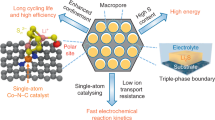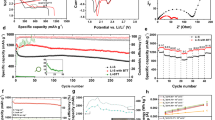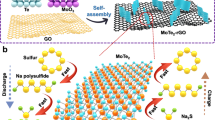Abstract
Batteries based on redox chemistries that can store more energy than state-of-the-art lithium-ion systems will play an important role in enabling the energy transition to net zero carbon emissions. Lithium–sulfur (Li–S) batteries have shown extraordinary promise, where the electrically insulating sulfur must be loaded onto a conducting host. Here we report the use of pre-lithiated metallic 1T phase two-dimensional (2D) molybdenum disulfide (LixMoS2) as a sulfur host material for high-performance Li–S batteries under lean electrolyte conditions. The lithiation of conductive and lyophilic 1T phase MoS2 nanosheets leads to improved adsorption of lithium polysulfides, enhanced Li+ transport, accelerated electrochemical reaction kinetics and superior electrocatalytic activity for polysulfide conversion. These attributes enable pouch cell batteries to deliver energy density of 441 Wh kg−1 and 735 Wh l−1, together with capacity retention of 85.2% after 200 cycles. Our results provide insights into the design of practical Li–S cathodes based on electrocatalytically active and conducting 2D materials.
This is a preview of subscription content, access via your institution
Access options
Access Nature and 54 other Nature Portfolio journals
Get Nature+, our best-value online-access subscription
$29.99 / 30 days
cancel any time
Subscribe to this journal
Receive 12 digital issues and online access to articles
$119.00 per year
only $9.92 per issue
Buy this article
- Purchase on Springer Link
- Instant access to full article PDF
Prices may be subject to local taxes which are calculated during checkout





Similar content being viewed by others
Data availability
All data supporting the findings of this study are available within the paper and Supplementary Information files. Source data are provided with this paper.
References
Manthiram, A., Fu, Y., Chung, S. H., Zu, C. & Su, Y. S. Rechargeable lithium-sulfur batteries. Chem. Rev. 114, 11751–11787 (2014).
Liang, J., Sun, Z. H., Li, F. & Cheng, H. M. Carbon materials for Li–S batteries: functional evolution and performance improvement. Energy Storage Mater. 2, 76–106 (2016).
Bhargav, A., He, J., Gupta, A. & Manthiram, A. Lithium–sulfur batteries: attaining the critical metrics. Joule 4, 285–291 (2020).
Liu, Y. T., Liu, S., Li, G. R. & Gao, X. P. Strategy of enhancing the volumetric energy density for lithium–sulfur batteries. Adv. Mater. 33, 2003955 (2021).
Zhao, C. et al. A high-energy and long-cycling lithium–sulfur pouch cell via a macroporous catalytic cathode with double-end binding sites. Nat. Nanotechnol. 16, 166–173 (2021).
Pang, Q., Liang, X., Kwok, C. Y. & Nazar, L. F. Advances in lithium–sulfur batteries based on multifunctional cathodes and electrolytes. Nat. Energy 1, 16132 (2016).
Eda, G. et al. Photoluminescence from chemically exfoliated MoS2. Nano Lett. 11, 5111–5116 (2011).
Chhowalla, M. et al. The chemistry of two-dimensional layered transition metal dichalcogenide nanosheets. Nat. Chem. 5, 263–275 (2013).
Acerce, M., Voiry, D. & Chhowalla, M. Metallic 1T phase MoS2 nanosheets as supercapacitor electrode materials. Nat. Nanotechnol. 10, 313–318 (2015).
Acerce, M., Akdoan, E. K. & Chhowalla, M. Metallic molybdenum disulfide nanosheet-based electrochemical actuators. Nature 549, 370–373 (2017).
Voiry, D. et al. Conducting MoS2 nanosheets as catalysts for hydrogen evolution reaction. Nano Lett. 13, 6222–6227 (2013).
Voiry, D. et al. The role of electronic coupling between substrate and 2D MoS2 nanosheets in electrocatalytic production of hydrogen. Nat. Mater. 15, 1003–1009 (2016).
Huang, X., Zeng, Z. & Zhang, H. Metal dichalcogenide nanosheets: preparation, properties and applications. Chem. Soc. Rev. 42, 1934–1946 (2013).
Huang, X. et al. Solution-phase epitaxial growth of noble metal nanostructures on dispersible single-layer molybdenum disulfide nanosheets. Nat. Commun. 4, 1444 (2013).
Xue, W. et al. Intercalation-conversion hybrid cathodes enabling Li–S full-cell architectures with jointly superior gravimetric and volumetric energy densities. Nat. Energy 4, 374–382 (2019).
Bard, A. J. & Faulkner, L. R. Electrochemical Methods: Fundamentals and Applications (Wiley, 2001).
Ogihara, N. et al. Theoretical and experimental analysis of porous electrodes for lithium-ion batteries by electrochemical impedance spectroscopy using a symmetric cell. J. Electrochem. Soc. 159, A1034–A1039 (2012).
Lu, Y. C., He, Q. & Gasteiger, H. A. Probing the lithium-sulfur redox reactions: a rotating-ring disk electrode study. J. Phys. Chem. C. 118, 5733–5741 (2014).
Liang, X. et al. A highly efficient polysulfide mediator for lithium–sulfur batteries. Nat. Commun. 6, 5682 (2015).
Bediako, D. K. et al. Heterointerface effects in the electrointercalation of van der Waals heterostructures. Nature 558, 425–429 (2018).
Mao, Y. et al. Foldable interpenetrated metal-organic frameworks/carbon nanotubes thin film for lithium–sulfur batteries. Nat. Commun. 8, 14628 (2017).
Duffner, F. et al. Post-lithium-ion battery cell production and its compatibility with lithium-ion cell production infrastructure. Nat. Energy 6, 123–134 (2021).
Chen, J. et al. Improving lithium–sulfur battery performance under lean electrolyte through nanoscale confinement in soft swellable gels. Nano Lett. 17, 3061–3067 (2017).
Pang, Q., Liang, X., Kwok, C. Y., Kulisch, J. & Nazar, L. F. A comprehensive approach toward stable lithium–sulfur batteries with high volumetric energy density. Adv. Energy Mater. 7, 1601630 (2017).
Sun, Y., Kong, L., Abbas Khan, H. & Pecht, M. G. Li-ion battery reliability—a case study of the Apple iPhone®. IEEE Access 7, 71131–71141 (2019).
Yuan, Z. et al. Hierarchical free-standing carbon-nanotube paper electrodes with ultrahigh sulfur-loading for lithium-sulfur batteries. Adv. Funct. Mater. 24, 6105–6112 (2014).
Qie, L., Zu, C. & Manthiram, A. A high energy lithium–sulfur battery with ultrahigh-loading lithium polysulfide cathode and its failure mechanism. Adv. Energy Mater. 6, 1502459 (2016).
Liu, J. et al. Exploiting a robust biopolymer network binder for an ultrahigh-areal-capacity Li–S battery. Energy Environ. Sci. 10, 750–755 (2017).
Lv, D. et al. High energy density lithium–sulfur batteries: challenges of thick sulfur cathodes. Adv. Energy Mater. 5, 1402290 (2015).
Li, Z., Zhang, J. T., Chen, Y. M., Li, J. & Lou, X. W. Pie-like electrode design for high-energy density lithium-sulfur batteries. Nat. Commun. 6, 8850 (2015).
Chung, S. H., Chang, C. H. & Manthiram, A. Robust, ultra-tough flexible cathodes for high-energy Li–S batteries. Small 12, 939–950 (2016).
Li, L. et al. A foldable lithium–sulfur battery. ACS Nano 9, 11342–11350 (2015).
Jin, K. et al. Sulfur/carbon nanotube composite film as a flexible cathode for lithium–sulfur batteries. J. Phys. Chem. C. 117, 21112–21119 (2013).
Zhou, G., Zhao, Y. & Manthiram, A. Dual-confined flexible sulfur cathodes encapsulated in nitrogen-doped double-shelled hollow carbon spheres and wrapped with graphene for Li–S batteries. Adv. Energy Mater. 5, 1402263 (2015).
Huang, J. Q. et al. Flexible all-carbon interlinked nanoarchitectures as cathode scaffolds for high-rate lithium–sulfur batteries. J. Mater. Chem. A 2, 10869–10875 (2014).
Zhou, G., Zhao, Y., Zu, C. & Manthiram, A. Free-standing TiO2 nanowire-embedded graphene hybrid membrane for advanced Li/dissolved polysulfide batteries. Nano Energy 12, 240–249 (2015).
Zhou, W., Guo, B., Gao, H. & Goodenough, J. B. Low-cost higher loading of a sulfur cathode. Adv. Energy Mater. 6, 1502059 (2016).
Kang, H. S. & Sun, Y. K. Freestanding bilayer carbon-sulfur cathode with function of entrapping polysulfide for high performance Li–S batteries. Adv. Funct. Mater. 26, 1225–1232 (2016).
Chen, H. et al. Rational design of cathode structure for high rate performance lithium–sulfur batteries. Nano Lett. 15, 5443–5448 (2015).
Kim, J. S., Hwang, T. H., Kim, B. G., Min, J. & Choi, J. W. A lithium–sulfur battery with a high areal energy density. Adv. Funct. Mater. 24, 5359–5367 (2014).
Park, J. et al. Unusually high ion conductivity in large-scale patternable two-dimensional MoS2 film. ACS Nano 15, 12267–12275 (2021).
Cheng, X. B. et al. The gap between long lifespan Li–S coin and pouch cells: the importance of lithium metal anode protection. Energy Storage Mater. 6, 18–25 (2017).
Luo, L., Chung, S. H., Yaghoobnejad Asl, H. & Manthiram, A. Long-life lithium–sulfur batteries with a bifunctional cathode substrate configured with boron carbide nanowires. Adv. Mater. 30, 1804149 (2018).
Luo, L., Li, J., Yaghoobnejad Asl, H. & Manthiram, A. In-situ assembled VS4 as a polysulfide mediator for high-loading lithium–sulfur batteries. ACS Energy Lett. 5, 1177–1185 (2020).
Zhang, G. et al. The radical pathway based on a lithium-metal-compatible high-dielectric dlectrolyte for lithium–sulfur batteries. Angew. Chem. Int. Ed. 57, 16732–16736 (2018).
Xie, Y. et al. Semi-flooded sulfur cathode with ultralean absorbed electrolyte in Li–S battery. Adv. Sci. 7, 1903168 (2020).
He, J., Chen, Y. & Manthiram, A. Vertical Co9S8 hollow nanowall arrays grown on a Celgard separator as a multifunctional polysulfide barrier for high-performance Li–S batteries. Energy Environ. Sci. 11, 2560–2568 (2018).
Kim, M. S. et al. Facile and scalable fabrication of high-energy-density sulfur cathodes for pragmatic lithium–sulfur batteries. J. Power Sources 422, 104–112 (2019).
Sun, H. et al. Three-dimensional holey-graphene/niobia composite architectures for ultrahigh-rate energy storage. Science 356, 599–604 (2017).
Moshtev, R. & Johnson, B. State of the art of commercial Li ion batteries. J. Power Sources 91, 86–91 (2000).
Cui, L. F., Yang, Y., Hsu, C. M. & Yi, C. Carbon-silicon core-shell nanowires as high capacity electrode for lithium ion batteries. Nano Lett. 9, 3370–3374 (2009).
Li, Y. et al. Growth of conformal graphene cages on micrometre-sized silicon particles as stable battery anodes. Nat. Energy 1, 15029 (2016).
Wang, X., Yan, C., Yan, J., Sumboja, A. & Lee, P. S. Orthorhombic niobium oxide nanowires for next generation hybrid supercapacitor device. Nano Energy 11, 765–772 (2015).
Billaud, J., Bouville, F., Magrini, T., Villevieille, C. & Studart, A. R. Magnetically aligned graphite electrodes for high-rate performance Li-ion batteries. Nat. Energy 1, 16097 (2016).
Wang, W. et al. Lithium phosphorus oxynitride as an efficient protective layer on lithium metal anodes for advanced lithium–sulfur batteries. Energy Storage Mater. 18, 414–422 (2019).
Shi, L. et al. Reaction heterogeneity in practical high-energy lithium–sulfur pouch cells. Energy Environ. Sci. 13, 3620–3632 (2020).
Wu, F. et al. Sulfur nanodots stitched in 2D ‘bubble-like’ interconnected carbon fabric as reversibility-enhanced cathodes for lithium–sulfur batteries. ACS Nano 11, 4694–4702 (2017).
Shaibani, M. et al. Expansion-tolerant architectures for stable cycling of ultrahigh-loading sulfur cathodes in lithium–sulfur batteries. Sci. Adv. 6, eaay2757 (2020).
Peng, Y. Q. et al. Full-range redox mediation on sulfur redox kinetics for high-performance lithium–sulfur batteries. Batteries Supercaps 5, e202100359 (2022).
Li, X.-Y. et al. Regulating lithium salt to inhibit surface gelation on an electrocatalyst for high-energy-density lithium–sulfur batteries. J. Am. Chem. Soc. 144, 14638–14646 (2022).
Zhao, C. X. et al. Semi-immobilized molecular electrocatalysts for high-performance lithium–sulfur batteries. J. Am. Chem. Soc. 143, 19865–19872 (2021).
Ye, Y. et al. Toward practical high-energy batteries: a modular-assembled oval-like carbon microstructure for thick sulfur electrodes. Adv. Mater. 29, 1700598 (2017).
Cheng, Q. et al. Constructing a 700 Wh kg−1-level rechargeable lithium–sulfur pouch cell. J. Energy Chem. 76, 181–186 (2022).
Acknowledgements
This work was supported by the Faraday Institution LiSTAR programme and characterization project (EP/S003053/1, FIRG014 and FIRG012) and the Engineering and Physical Sciences Research Council (EPSRC) (EP/T001038/1, EP/L016087/1).
Author information
Authors and Affiliations
Contributions
M.C. conceived and designed the research; Z.L., I.S., J.Y. and J.L. performed the experiments and the characterization of the materials; Z.L. and M.C. analysed the data and M.C. wrote the manuscript with input from Z.L. All the authors commented on the manuscript.
Corresponding authors
Ethics declarations
Competing interests
The authors declare no competing interests.
Peer review
Peer review information
Nature Energy thanks Wonbong Choi and the other, anonymous, reviewer(s) for their contribution to the peer review of this work.
Additional information
Publisher’s note Springer Nature remains neutral with regard to jurisdictional claims in published maps and institutional affiliations.
Supplementary information
Supplementary Information
Supplementary Figs. 1–11 and Tables 1 and 2.
Rights and permissions
Springer Nature or its licensor (e.g. a society or other partner) holds exclusive rights to this article under a publishing agreement with the author(s) or other rightsholder(s); author self-archiving of the accepted manuscript version of this article is solely governed by the terms of such publishing agreement and applicable law.
About this article
Cite this article
Li, Z., Sami, I., Yang, J. et al. Lithiated metallic molybdenum disulfide nanosheets for high-performance lithium–sulfur batteries. Nat Energy 8, 84–93 (2023). https://doi.org/10.1038/s41560-022-01175-7
Received:
Accepted:
Published:
Issue Date:
DOI: https://doi.org/10.1038/s41560-022-01175-7
This article is cited by
-
Chlorine bridge bond-enabled binuclear copper complex for electrocatalyzing lithium–sulfur reactions
Nature Communications (2024)
-
Recent advances on liquid intercalation and exfoliation of transition metal dichalcogenides: From fundamentals to applications
Nano Research (2024)
-
Customizing MXene@CoSe2 for cathode host of lithium–sulfur batteries to promote the redox kinetics of lithium polysulfides
Journal of Materials Science: Materials in Electronics (2024)
-
Boosting Lean Electrolyte Lithium–Sulfur Battery Performance with Transition Metals: A Comprehensive Review
Nano-Micro Letters (2023)
-
Towards Practical Application of Li–S Battery with High Sulfur Loading and Lean Electrolyte: Will Carbon-Based Hosts Win This Race?
Nano-Micro Letters (2023)



